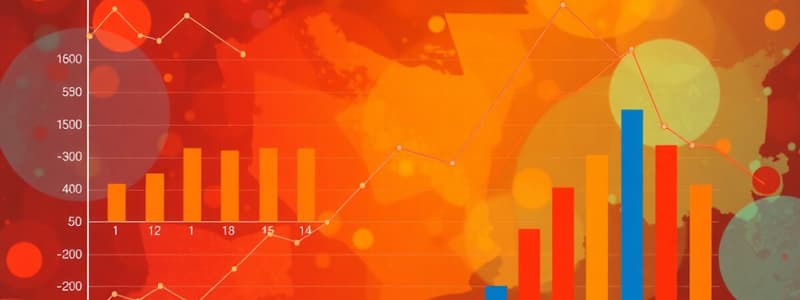Podcast
Questions and Answers
Which of the following best describes continuous data?
Which of the following best describes continuous data?
- Data that can only take specific values.
- Data that can be counted but not measured.
- Data that can only be represented as whole numbers.
- Data that can take any value within a given range. (correct)
What characterizes a normal distribution?
What characterizes a normal distribution?
- It has a skewed shape.
- It describes a fixed number of events occurring.
- It exhibits a symmetric, bell-shaped curve. (correct)
- All outcomes are equally likely.
Which sampling technique involves dividing the population into subgroups and taking random samples from each?
Which sampling technique involves dividing the population into subgroups and taking random samples from each?
- Cluster sampling.
- Systematic sampling.
- Stratified sampling. (correct)
- Simple random sampling.
Which statistical software package is primarily known for its capability in advanced data analysis and visualization?
Which statistical software package is primarily known for its capability in advanced data analysis and visualization?
In which scenario would a binomial distribution be appropriately used?
In which scenario would a binomial distribution be appropriately used?
Which measure of central tendency is the most affected by extreme values in a dataset?
Which measure of central tendency is the most affected by extreme values in a dataset?
What does a confidence interval provide in the context of inferential statistics?
What does a confidence interval provide in the context of inferential statistics?
Which of the following tracks the relationship between two variables in inferential statistics?
Which of the following tracks the relationship between two variables in inferential statistics?
In probability theory, what does the sample space represent?
In probability theory, what does the sample space represent?
Which type of data specifically represents categories or groups?
Which type of data specifically represents categories or groups?
Which measure of variability indicates the average distance of each data point from the mean?
Which measure of variability indicates the average distance of each data point from the mean?
What do skewness and kurtosis measure in a dataset?
What do skewness and kurtosis measure in a dataset?
In a random experiment, if the probability of event A occurring is 0.7, what is the probability of event A not occurring?
In a random experiment, if the probability of event A occurring is 0.7, what is the probability of event A not occurring?
Flashcards
Statistical Distribution
Statistical Distribution
Describes the pattern of how data points are distributed.
Discrete Data
Discrete Data
Numerical data that can only take on specific values, often whole numbers. Examples include the number of students in a class or the number of cars in a parking lot.
Continuous Data
Continuous Data
Numerical data that can take on any value within a given range. Examples include height, weight, or temperature.
Sampling Technique
Sampling Technique
Signup and view all the flashcards
Normal Distribution
Normal Distribution
Signup and view all the flashcards
Descriptive Statistics
Descriptive Statistics
Signup and view all the flashcards
Measures of Central Tendency
Measures of Central Tendency
Signup and view all the flashcards
Measures of Variability
Measures of Variability
Signup and view all the flashcards
Inferential Statistics
Inferential Statistics
Signup and view all the flashcards
Hypothesis Testing
Hypothesis Testing
Signup and view all the flashcards
Probability
Probability
Signup and view all the flashcards
Data Types
Data Types
Signup and view all the flashcards
Data Visualization
Data Visualization
Signup and view all the flashcards
Study Notes
Descriptive Statistics
- Descriptive statistics summarizes data.
- It describes data without making inferences about a larger population.
- Key measures include:
- Measures of central tendency: mean, median, mode. These represent typical values.
- Measures of variability (dispersion): range, variance, standard deviation. These show data spread.
- Measures of shape: skewness, kurtosis. These describe the distribution's symmetry.
- Data visualization is crucial. Examples include: histograms, box plots, scatterplots, and bar charts.
- These visual representations display patterns, trends, and outliers.
Inferential Statistics
- Inferential statistics uses sample data to make conclusions about a broader population.
- It goes beyond describing the sample.
- Methods include:
- Hypothesis testing: determines if a claim about a population parameter is supported by the sample.
- Confidence intervals: provides a range of plausible values for a population parameter along with a confidence level.
- Regression analysis: examines relationships between two or more variables.
- Correlation analysis: measures the strength and direction of a linear relationship between two variables.
Probability
- Probability quantifies uncertainty.
- It deals with the likelihood of events.
- Key concepts include:
- Random experiments: experiments with unpredictable outcomes.
- Sample space: all possible outcomes of an experiment.
- Event: a subset of possible outcomes.
- Probability of an event: numerical measure of likelihood.
- Basic rules: Probability is between 0 and 1, the sum of probabilities for all outcomes is 1, the probability of an event not occurring equals 1 minus the probability of the event occurring.
Data Types
- Data types include:
- Categorical data: represents categories (e.g., gender, color).
- Numerical data: represents numerical values, further divided into:
- Discrete data: specific values (e.g., number of students).
- Continuous data: any value within a range (e.g., height).
Statistical Distributions
- Distributions describe data patterns.
- Common distributions include:
- Normal distribution: symmetric, bell-shaped curve.
- Binomial distribution: probability of successes in a fixed number of trials.
- Poisson distribution: probability of events occurring in a fixed interval.
- Uniform distribution: all outcomes are equally likely.
- Knowing the distribution helps apply inferential methods correctly.
Sampling Techniques
- Sampling selects a subset from a population to represent the entire population.
- Techniques include:
- Simple random sampling: every member has an equal chance.
- Stratified sampling: subgroups (strata) are sampled.
- Cluster sampling: clusters of the population are sampled.
- Systematic sampling: members are selected at regular intervals.
Statistical Software
- Statistical software packages perform analysis.
- Common packages include R, SPSS, and SAS.
- These automate calculations, visualizations, and statistical tests.
Studying That Suits You
Use AI to generate personalized quizzes and flashcards to suit your learning preferences.




